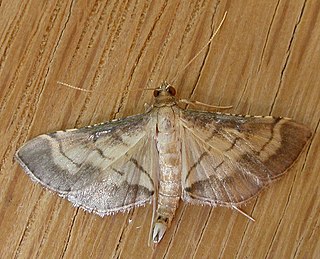Cotton bollworms are a significant pest of cotton. "A major pest in hot countries of irrigated crops. Enters into a summer diapause when irrigated crops are not present and the soil and air temperatures are high. When the end of the dry season comes, the rain cools the soil and pupae come out of diapause."

Bollworm is the common term for a moth larva that attacks the fruiting bodies of certain crops, especially cotton. The most common moths known as bollworms are:

Earias is a genus of moths in the monotypic subfamily Eariadinae of the family Nolidae. The genus was erected by Jacob Hübner in 1825. Species are found throughout Europe, Africa, Asia and Australia, some being agricultural pests such as bollworms.

Earias perhuegeli, the rough bollworm, is a moth of the family Nolidae. The species was first described by Jeremy Daniel Holloway in 1977. It is found in the northern two-thirds of Australia and several islands in the South Pacific.

Cnaphalocrocis poeyalis, the lesser rice-leafroller, is a species of moth of the family Crambidae described by Jean Baptiste Boisduval in 1833. They can be found from Africa to the Pacific region, including Australia, Réunion, India, Fiji, Hong Kong and French Polynesia.

Bastilla angularis is a moth of the family Noctuidae first described by Jean Baptiste Boisduval in 1833. It has an Oriental and Panafrican distribution. India, it is found in Eswatini, Gabon, Cabo Verde, São Tomé, Réunion and Madagascar.

Rhynocoris albopunctatus is a species of assassin bug family (Reduviidae), in the subfamily Harpactorinae. It is common in cotton plantations, especially near pastures where Stylosanthes gracilis is incorporated.

Cleora acaciaria is a moth of the family Geometridae described by Jean Baptiste Boisduval in 1833. It is found in Angola, Cameroon, Comoros, Congo, Ghana, Madagascar, Réunion São Tomé and Príncipe and the United Arab Emirates.

Earias biplaga, the spiny bollworm, is a moth in the family Nolidae. The species was first described by Francis Walker in 1866. It is found throughout subtropical Africa including Atlantic and Indian Ocean islands.

Polydesma umbricola, the monkeypod moth or large tabby, is a species of moth in the family Erebidae. The species is found in southern Europe, Africa, Asia Minor to southern Asia, of India, Sri Lanka, Maldives, the Andaman Islands, including many Indian Ocean islands, like Coëtivy Island, Aldabra, Assumption Island, Madagascar and on Hawaii.

Caradrina selini is a moth of the family Noctuidae. It was described by Jean Baptiste Boisduval in 1840. It is found in most of Europe, North Africa and the Near East.

Earias cupreoviridis, called the cupreous bollworm as a larva, is a moth of the family Nolidae. The species was first described by Francis Walker in 1862. It is found in African countries like Botswana, the Democratic Republic of the Congo, Eritrea, Ethiopia, the Gambia, Kenya, Nigeria, Sierra Leone, South Africa, Togo, Uganda, Zimbabwe to Asian countries like India, Sri Lanka, China, Japan, Korea, Philippines, Indonesia and Hong Kong.
Earias fabia, called the cotton spotted bollworm as a larva, is a moth of the family Nolidae. The species was first described by Caspar Stoll in 1781. It is sometimes included in the species Earias vittella.










